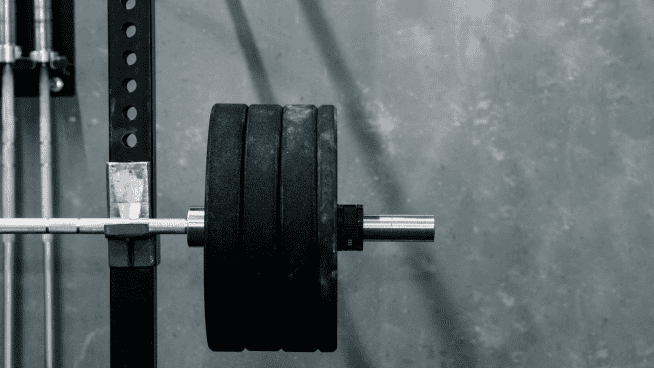The Strategy That Helped Tommy Bohanon Demolish the NFL Combine Bench Press Test
Tommy Bohanon’s strength is the stuff of legend.
We’ve already detailed the outrageous workouts where he regularly makes 400-pound Cleans look like warm-up weight. But the 28-year-old NFL fullback also cranked out an absurd 36 reps on the 225 Bench Test at the 2013 NFL Combine. It’s the second-most reps by any offensive skill player since the year 2000.
Paired with a 35-inch Vertical Jump, the performance helped Bohanon get drafted. During STACK’s recent interview, we quizzed Bohanon on how he was able to put up such an absurd number of reps. Here’s what he had to say:
“I really learned how to get as many reps in a short amount of time as possible. It seems to be that everyone kinda tires out at the same amount of time. But it just matters how many reps you can get in that certain amount of time. I think the time was somewhere in 30-45 seconds. (That’s) when you hit that lactic threshold. That being said, you’re trying to push and pull the weight back down and up as fast as possible. That was kind of my technique was to pull the weight back down as soon as I locked out so that I could get as many reps in that short amount of time as possible.”
Bohanon’s answer makes a ton of sense. The longer that bar is in your hands, the longer your upper-body muscles are going to be under tension. You might not think holding a bar at lock out takes much energy, but see for yourself—take a barbell loaded with 70% of your one-rep max, and see how many reps you can do before failure (use a spotter). Then, try un-racking that same weight and holding it at lockout for 30 seconds before seeing how many reps you can get. The difference will likely be massive.
Whatever pace you press at, you’re likely going to hit a major wall due to muscular failure around 30-45 seconds in. Knowing that, you’ll want to go fast to get as many reps in that window as possible.
A good coach would never encourage athletes to pull the bar “down” during the eccentric portion of a movement, as Bohanon describes—except for on the 225 Bench Press test.
In his guide to training for the 225 Bench Press test, renowned strength and conditioning coach Mike Boyle writes, “I always tell my athletes to control the weight at all times, except when benching 225. When benching 225, I tell my athletes to go as fast as possible…I always tell my athletes to lock out every rep, except when benching 225…I teach this specific event having nothing in common with anything else I teach an athlete about strength training.”
Although we had a tough time tracking down video of Bohanon benching at the Combine, this video of Stephen Paea, who put up a mind-boggling 49 reps at the 2011 NFL Draft, illustrates his point:
[youtube video=”Oko9qnYgoxU”]See how fast that bar is moving? Paea puts up 38 reps in the first 30 seconds of the test. The final 11 reps are drawn out over the final 23 seconds. Of course, you have to get pretty dang strong to move the bar fast enough for such a tactic to make a major difference in your result. Bohanon was doing banded Bench Press reps with 440 pounds when he was still in college, so he had an awesome foundation of strength well before he began specifically training for this test. One great method of training just about anyone can use to prepare for a Bench Press test is to utilize rest-pause sets during their training.
READ MORE:
RECOMMENDED FOR YOU
MOST POPULAR
The Strategy That Helped Tommy Bohanon Demolish the NFL Combine Bench Press Test
Tommy Bohanon’s strength is the stuff of legend.
We’ve already detailed the outrageous workouts where he regularly makes 400-pound Cleans look like warm-up weight. But the 28-year-old NFL fullback also cranked out an absurd 36 reps on the 225 Bench Test at the 2013 NFL Combine. It’s the second-most reps by any offensive skill player since the year 2000.
Paired with a 35-inch Vertical Jump, the performance helped Bohanon get drafted. During STACK’s recent interview, we quizzed Bohanon on how he was able to put up such an absurd number of reps. Here’s what he had to say:
“I really learned how to get as many reps in a short amount of time as possible. It seems to be that everyone kinda tires out at the same amount of time. But it just matters how many reps you can get in that certain amount of time. I think the time was somewhere in 30-45 seconds. (That’s) when you hit that lactic threshold. That being said, you’re trying to push and pull the weight back down and up as fast as possible. That was kind of my technique was to pull the weight back down as soon as I locked out so that I could get as many reps in that short amount of time as possible.”
Bohanon’s answer makes a ton of sense. The longer that bar is in your hands, the longer your upper-body muscles are going to be under tension. You might not think holding a bar at lock out takes much energy, but see for yourself—take a barbell loaded with 70% of your one-rep max, and see how many reps you can do before failure (use a spotter). Then, try un-racking that same weight and holding it at lockout for 30 seconds before seeing how many reps you can get. The difference will likely be massive.
Whatever pace you press at, you’re likely going to hit a major wall due to muscular failure around 30-45 seconds in. Knowing that, you’ll want to go fast to get as many reps in that window as possible.
A good coach would never encourage athletes to pull the bar “down” during the eccentric portion of a movement, as Bohanon describes—except for on the 225 Bench Press test.
In his guide to training for the 225 Bench Press test, renowned strength and conditioning coach Mike Boyle writes, “I always tell my athletes to control the weight at all times, except when benching 225. When benching 225, I tell my athletes to go as fast as possible…I always tell my athletes to lock out every rep, except when benching 225…I teach this specific event having nothing in common with anything else I teach an athlete about strength training.”
Although we had a tough time tracking down video of Bohanon benching at the Combine, this video of Stephen Paea, who put up a mind-boggling 49 reps at the 2011 NFL Draft, illustrates his point:
[youtube video=”Oko9qnYgoxU”]See how fast that bar is moving? Paea puts up 38 reps in the first 30 seconds of the test. The final 11 reps are drawn out over the final 23 seconds. Of course, you have to get pretty dang strong to move the bar fast enough for such a tactic to make a major difference in your result. Bohanon was doing banded Bench Press reps with 440 pounds when he was still in college, so he had an awesome foundation of strength well before he began specifically training for this test. One great method of training just about anyone can use to prepare for a Bench Press test is to utilize rest-pause sets during their training.
READ MORE:










